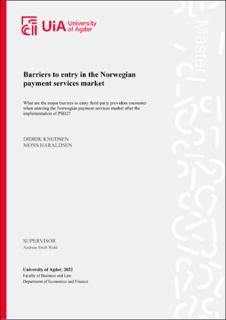| dc.description.abstract | The purpose of the Revised Payment Services Directive was to ensure efficient and integrated financial services, and to increase market competition and innovation across the EU and EEA. PSD2 was put forth to lower the barriers to entry for the payment services market, hence allowing new entrants to compete with incumbents, and incumbents to compete with each other to increase both competition and innovation. In Norway the number of new entrants is rather low relative to comparable countries. The PSD2 regulative brings new possibilities for third-party providers, but it does not entail a market entry without barriers. This research has taken a qualitative approach to identify entry barriers that new TPPs have faced or will face when entering the payment services market in Norway. Semi-structured interviews were conducted with 11 participants representing fintechs, banks and neutral consultants to answer the research question.
We have found that there are a number of entry barriers in the payment services market. The most prominent findings of this study were the quality of the APIs the banks have been required to produce, the banks guarding of exclusive control over strategic resources in form of consumer data, gaps in information and technical knowledge from the Financial Supervisory Authority of Norway, and access to financing of Norwegian fintech companies in the payment services market. | |
